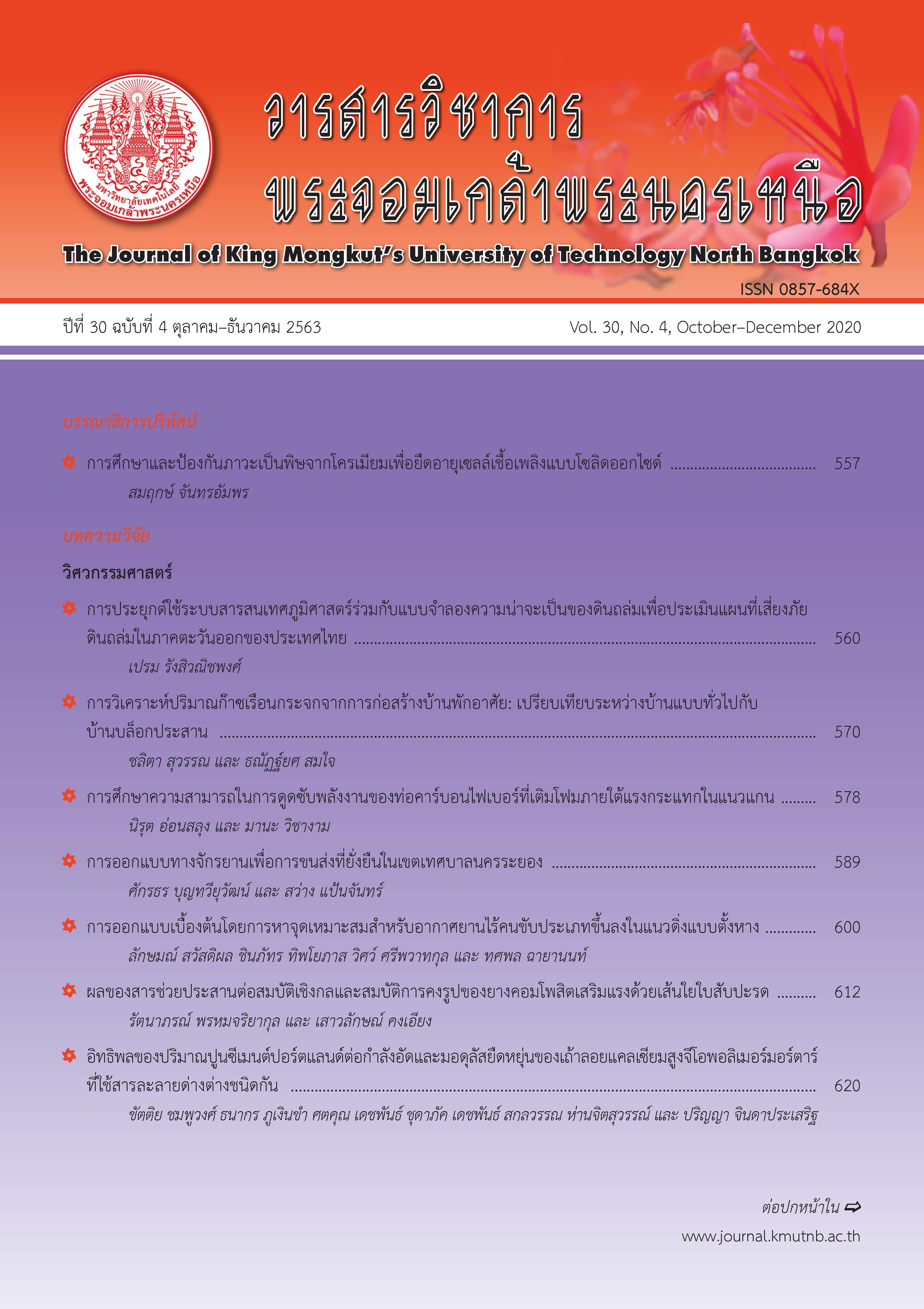ผลของสารช่วยประสานต่อสมบัติเชิงกลและสมบัติการคงรูปของยางคอมโพสิตเสริมแรงด้วยเส้นใยใบสับปะรด
Main Article Content
บทคัดย่อ
งานวิจัยนี้ต้องการปรับปรุงความเข้ากันได้ของยางธรรมชาติกับเส้นใยใบสับปะรดด้วยสารเชื่อมประสานยางธรรมชาติอิพ็อกซิไดซ์ (ENR25) โดยมีวัตถุประสงค์เพื่อศึกษาอิทธิพลของสารช่วยประสานต่อสมบัติเชิงกล และสมบัติการคงรูปของยางคอมโพสิตเสริมแรงด้วยเส้นใยใบสับปะรด ยางคอมโพสิตถูกเตรียมโดยนำยางธรรมชาติผสมกับเส้นใยใบสับปะรดและยางธรรมชาติอิพ็อกซิไดซ์ที่ 0, 5, 10 และ 15 phr ตามลำดับ ด้วยเครื่องผสมแบบสองลูกกลิ้ง (Two Roll Mill) จากนั้นขึ้นรูปชิ้นงานทดสอบด้วยเครื่องกดอัดแบบร้อน (Compression Molding) แล้วทดสอบสมบัติการคงรูปและสมบัติเชิงกล พบว่า เมื่อเพิ่มปริมาณการเติม ENR25 ในยางคอมโพสิต ค่าร้อยละการยืดตัว ณ จุดขาด และค่าความต้านทานการฉีกขาดมีค่าเพิ่มขึ้น ในขณะที่ค่าความต้านทานแรงดึงค่ามอดุลัสที่ 100 เปอร์เซ็นต์การดึงยืด เวลาในการไหลตัวในแม่พิมพ์ (Scorch Time) และเวลาในการคงรูป (Cure Time) ไม่เปลี่ยนแปลงอย่างชัดเจน
Article Details
บทความที่ลงตีพิมพ์เป็นข้อคิดเห็นของผู้เขียนเท่านั้น
ผู้เขียนจะต้องเป็นผู้รับผิดชอบต่อผลทางกฎหมายใดๆ ที่อาจเกิดขึ้นจากบทความนั้น
เอกสารอ้างอิง
[2] N. Lopattananon, K. Panawarangkul, K. Sahakaro, and B. Ellis, “Performance of pineapple leaf fiber–natural rubber composites: The effect of fiber surface treatments,” Applied Polymer Science, vol. 102, pp. 1974–1984, 2006.
[3] TPIA Resource Center: Pineapple history, Tips & Health Benefits. (2017). We welcome you to Thailand, Land of Pineapples. Thai Pineapple Industry Association. Bangkok, Thailand [Online]. Available: (http://www.thaipineapple.org/index.php?lay=show&ac=article&Id=538719866.
[4] N. Hariwongsanupab, S. Thanawan, T. Amornsakchai, M. F. Vallat, and K. Mougin, “Improving the mechanical properties of short pineapple leaf fiber reinforced natural rubber by blending with acrylonitrile butadiene rubber,” Polymer Testing, vol. 57, pp. 94–100, 2017.
[5] W. Wongsarat, N. Suppakarn, and K. Jarukujorn, “Effects of compatibilizer type and fiber loading on mechanical properties and cure characteristics of sisal fiber/natural rubber composites,” Journal of Composite Materials, vol. 48, no. 19, pp. 2401–2411, 2013.
[6] H. Ismail and F. S. Haw, “Effects of palm ash loading and maleated natural rubber as a coupling agent on the properties of palm-ash-filled natural rubber composites,” Applied Polymer Science, vol. 110, no. 5, pp. 2867–2876, 2008.
[7] H. Ismail, M. R. Edyham, and B. Wirjosentono, “Bamboo fibre filled natural rubber composites: The effects of filler loading and bonding agent,” Polymer Testing, vol. 21, no. 2, pp. 139–144, 2002.
[8] P. L. Teh, Z. A. Mohd Ishak, A. S. Hashim, J. Karger-Kocsis, and U. S. Ishiaku, “Effects of epoxidized natural rubber as a compatibilizer in melt compounded natural rubber– organoclay nanocomposites,” European Polymer Journal, vol. 40, no. 11, pp. 2513–2521, 2004.
[9] W. Wongsarat, N. Suppakarn, and K. Jarukumjon, “Mechanical properties, morphological properties, and cure characteristics of sisal fiber/natural rubber composites: Effects of fiber and compatibilizer content,” Advanced Materials Research, vol. 123–125, pp. 1171–1173, 2010.
[10] H. Ismail,H. D. Rozman, R. M. Jaffri, and S. A. Mohd Ishak, “Oil palm wood flour reinforced epoxidized natural rubber composites: The effect of filler content and size,” European Polymer Journal, vol. 33, no. 10–12, pp. 1627–1632, 1997.
[11] N. Kengkhetkit and T. Amornsakchai, “Utilisation of pineapple leaf waste for plastic reinforcement: 1. A novel extraction method for short pineapple leaf fiber,” Industrial Crops and Products, vol. 40, pp. 55-61, 2012.
[12] L. Mathew and R. Joseph, “Mechanical properties of short-isora-fiber-reinforced natural rubber composites: Effects of fiber length, orientation, and loading; alkali treatment; and bonding agent,” Applied Polymer Science, vol. 103, no. 3, pp. 1640–1650, 2007.

